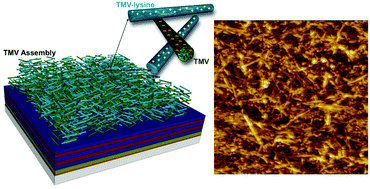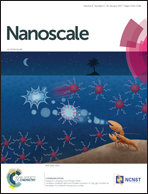Electrostatic layer-by-layer construction of fibrous TMV biofilms†
Abstract
As nature's choice in designing complex architectures, the bottom-up assembly of nanoscale building blocks offers unique solutions in achieving more complex and smaller morphologies with wide-ranging applications in medicine, energy, and materials science as compared to top-down manufacturing. In this work, we employ charged tobacco mosaic virus (TMV-wt and TMV-lys) nanoparticles in constructing multilayered fibrous networks via electrostatic layer-by-layer (LbL) deposition. In neutral aqueous media, TMV-wt assumes an anionic surface charge. TMV-wt was paired with a genetically engineered TMV-lys variant that displays a corona of lysine side chains on its solvent-exposed surface. The electrostatic interaction between TMV-wt and TMV-lys nanoparticles became the driving force in the highly controlled buildup of the multilayer TMV constructs. Since the resulting morphology closely resembles the 3-dimensional fibrous network of an extracellular matrix (ECM), the capability of the TMV assemblies to support the adhesion of NIH-3T3 fibroblast cells was investigated, demonstrating potential utility in regenerative medicine. Lastly, the layer-by-layer deposition was extended to release the TMV scaffolds as free-standing biomembranes. To demonstrate potential application in drug delivery or vaccine technology, cargo-functionalized TMV biofilms were programmed.



 Please wait while we load your content...
Please wait while we load your content...